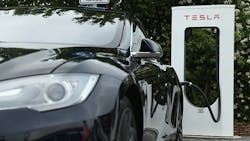Tesla Cars Can Now (Almost) Drive Themselves
SAN FRANCISCO — Tesla is taking a major step toward autonomous cars by installing new autopilot software Thursday in North America to automatically change lanes, manage speed and even hit the brakes.
Self-driving capabilities — previously limited to cars tested by technology titans such as Google — hit the streets “overnight” with the latest Tesla Version 7.0 software, the company said Wednesday. The so-called Version 7.0 software is due to hit the European and Asian markets next week after obtaining the required authorization.
The feature was unveiled Wednesday and is being added to thousands of Tesla’s Model S cars already on the road. As of June 30, Tesla had already sold nearly 80,000 of the four-door sedans.
“We’re being especially cautious at this early stage, so we are advising drivers to keep their hands on the wheel just in case,” Tesla founder and CEO Elon Musk told reporters. “In the long term, people will not need hands on the wheel, and eventually there won’t be (steering) wheels or pedals.”
Autopilot allows Model S to steer within a lane, change lanes by tapping a turn signal and manage speed using “traffic-aware” cruise control. The car can also scan for available parking spaces, alert drivers when one is spotted and then parallel park on command.
A year ago, the California-based company began equipping Model S cars with radar, cameras, ultrasonic sensors and other hardware to begin incrementally introducing self-driving capabilities. But the new software has its limits: It still can’t recognize the color of traffic lights.
On its website, Tesla acknowledged that “truly driverless cars are still a few years away.”
“Tesla Autopilot functions like the systems that airplane pilots use when conditions are clear,” it explained. “The driver is still responsible for, and ultimately in control of, the car.”
The autosteer capability is still in beta form, Musk stressed, adding that the system would be updating itself systematically across the whole network of connected cars.
Tesla sold about 11,580 Model S cars during the third quarter.
Model X SUVs, which the group put on the market several weeks ago in a limited release, are also due to get the software. But vehicle owners will have to pay an extra $2,500 for the autopilot software, either at the time of purchase or later.
Drivers Are Still in Charge, but Will Have to Adapt
Alongside the connected car, autonomous driving is one of the new buzzwords in the automobile sector. Most automakers are rushing to invest in driverless technology, seen as the future in the industry.
What makes Tesla stand out, however, is the fact that the cars are electric. The company boasts “supercar acceleration” that allows vehicles to go from zero to 60 miles per hour in 2.8 seconds.
Among the best developed autopilot prototypes is Alphabet’s Google Car, already on the road in several US states. The Google car uses the same technology as its fleet of Lexus SUVs, which has logged about a million miles.
Mercedes presented a futuristic car with a traffic-jam assist that allows the car to steer, brake and accelerate on its own at slow speeds.
And earlier this month, Toyota presented a car that can drive itself along a highway. The car, a modified Lexus GS, uses sophisticated sensors to navigate roads, merge lanes and overtake other vehicles. The company hopes to make other cars with similar features available within five years, in time for Tokyo’s hosting of the Olympics.
But South Korea’s Hyundai has warned about the complex legal challenges of self-driving cars. While fully autopilot systems without any human involvement could be ready by 2025, such technology would also bring with it “huge, huge challenges for our legal systems,” European operations chief Thomas Schmid cautioned.
“Who is responsible for what?” he asked. “I’m not convinced until now that is a process which can be done in the next 10-15 years.”
Indeed, existent law does not yet allow for completely autonomous, driver-less cars on the roads, and consumers will also have to adapt.
By Sophie Estienne
Copyright Agence France-Presse, 2015
About the Author
Agence France-Presse
Copyright Agence France-Presse, 2002-2025. AFP text, photos, graphics and logos shall not be reproduced, published, broadcast, rewritten for broadcast or publication or redistributed directly or indirectly in any medium. AFP shall not be held liable for any delays, inaccuracies, errors or omissions in any AFP content, or for any actions taken in consequence.
